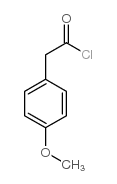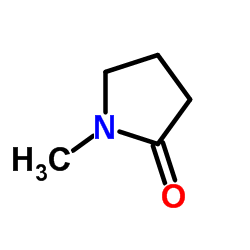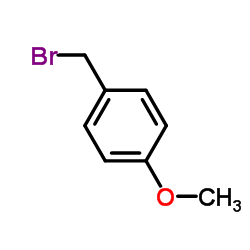4-METHOXYPHENYLACETYL CHLORIDE

4-METHOXYPHENYLACETYL CHLORIDE structure
|
Common Name | 4-METHOXYPHENYLACETYL CHLORIDE | ||
|---|---|---|---|---|
| CAS Number | 4693-91-8 | Molecular Weight | 184.62000 | |
| Density | 1.208 g/mL at 25 °C(lit.) | Boiling Point | 143 °C10 mm Hg(lit.) | |
| Molecular Formula | C9H9ClO2 | Melting Point | N/A | |
| MSDS | USA | Flash Point | >230 °F | |
| Symbol |

GHS05 |
Signal Word | Danger | |
| Name | 4-Methoxyphenylacetyl Chloride |
|---|---|
| Synonym | More Synonyms |
| Density | 1.208 g/mL at 25 °C(lit.) |
|---|---|
| Boiling Point | 143 °C10 mm Hg(lit.) |
| Molecular Formula | C9H9ClO2 |
| Molecular Weight | 184.62000 |
| Flash Point | >230 °F |
| Exact Mass | 184.02900 |
| PSA | 26.30000 |
| LogP | 2.00310 |
| Index of Refraction | n20/D 1.54(lit.) |
| Storage condition | 2-8°C |
Synonym:None Known Section 2 - COMPOSITION, INFORMATION ON INGREDIENTS
Risk Phrases: 34 Section 3 - HAZARDS IDENTIFICATION EMERGENCY OVERVIEW
Causes burns.Moisture sensitive. Potential Health Effects Eye: Causes eye burns. Lachrymator (substance which increases the flow of tears). Skin: Causes skin burns. Ingestion: Causes gastrointestinal tract burns. Inhalation: Causes chemical burns to the respiratory tract. Chronic: Chronic exposure may cause effects similar to those of acute exposure. Section 4 - FIRST AID MEASURES Eyes: Immediately flush eyes with plenty of water for at least 15 minutes, occasionally lifting the upper and lower eyelids. Get medical aid immediately. Do NOT allow victim to rub eyes or keep eyes closed. Skin: In case of contact, immediately flush skin with plenty of water for at least 15 minutes while removing contaminated clothing and shoes. Get medical aid immediately. Wash clothing before reuse. Ingestion: If swallowed, do NOT induce vomiting. Get medical aid immediately. If victim is fully conscious, give a cupful of water. Never give anything by mouth to an unconscious person. Inhalation: Get medical aid immediately. Remove from exposure and move to fresh air immediately. If not breathing, give artificial respiration. If breathing is difficult, give oxygen. Do NOT use mouth-to-mouth resuscitation. Notes to Physician: Treat symptomatically and supportively. Section 5 - FIRE FIGHTING MEASURES General Information: As in any fire, wear a self-contained breathing apparatus in pressure-demand, MSHA/NIOSH (approved or equivalent), and full protective gear. During a fire, irritating and highly toxic gases may be generated by thermal decomposition or combustion. Will burn if involved in a fire. Vapors may be heavier than air. They can spread along the ground and collect in low or confined areas. Runoff from fire control or dilution water may cause pollution. Extinguishing Media: Use foam, dry chemical, or carbon dioxide. Do NOT get water inside containers. Section 6 - ACCIDENTAL RELEASE MEASURES General Information: Use proper personal protective equipment as indicated in Section 8. Spills/Leaks: Absorb spill with inert material (e.g. vermiculite, sand or earth), then place in suitable container. Clean up spills immediately, observing precautions in the Protective Equipment section. Provide ventilation. Do not get water inside containers. Section 7 - HANDLING and STORAGE Handling: Do not breathe dust, vapor, mist, or gas. Do not get in eyes, on skin, or on clothing. Keep container tightly closed. Do not ingest or inhale. Use only in a chemical fume hood. Discard contaminated shoes. Keep from contact with moist air and steam. Storage: Store in a cool, dry place. Store in a tightly closed container. Corrosives area. Store protected from moisture. Store under nitrogen. Section 8 - EXPOSURE CONTROLS, PERSONAL PROTECTION Engineering Controls: Facilities storing or utilizing this material should be equipped with an eyewash facility and a safety shower. Use adequate ventilation to keep airborne concentrations low. Exposure Limits CAS# 4693-91-8: Personal Protective Equipment Eyes: Wear appropriate protective eyeglasses or chemical safety goggles as described by OSHA's eye and face protection regulations in 29 CFR 1910.133 or European Standard EN166. Skin: Wear appropriate protective gloves to prevent skin exposure. Clothing: Wear appropriate protective clothing to prevent skin exposure. Respirators: Follow the OSHA respirator regulations found in 29 CFR 1910.134 or European Standard EN 149. Use a NIOSH/MSHA or European Standard EN 149 approved respirator if exposure limits are exceeded or if irritation or other symptoms are experienced. Section 9 - PHYSICAL AND CHEMICAL PROPERTIES Physical State: Liquid Color: colorless Odor: Not available. pH: Not available. Vapor Pressure: Not available. Viscosity: Not available. Boiling Point: 143 deg C @10mmHg Freezing/Melting Point: Not available. Autoignition Temperature: Not available. Flash Point: > 110 deg C (> 230.00 deg F) Explosion Limits, lower: Not available. Explosion Limits, upper: Not available. Decomposition Temperature: Solubility in water: Specific Gravity/Density: 1.208 Molecular Formula: C9H9ClO2 Molecular Weight: 184.62 Section 10 - STABILITY AND REACTIVITY Chemical Stability: Moisture sensitive. Conditions to Avoid: Exposure to moist air or water. Incompatibilities with Other Materials: Strong oxidizing agents. Hazardous Decomposition Products: Hydrogen chloride, carbon monoxide, carbon dioxide. Hazardous Polymerization: Has not been reported Section 11 - TOXICOLOGICAL INFORMATION RTECS#: CAS# 4693-91-8 unlisted. LD50/LC50: Not available. Carcinogenicity: 4-Methoxyphenylacetyl chloride - Not listed by ACGIH, IARC, or NTP. Section 12 - ECOLOGICAL INFORMATION Ecotoxicity: Fish: Pseudomonas putida: Section 13 - DISPOSAL CONSIDERATIONS Dispose of in a manner consistent with federal, state, and local regulations. Section 14 - TRANSPORT INFORMATION IATA Shipping Name: CORROSIVE LIQUID, ACIDIC, ORGANIC, N.O.S.* Hazard Class: 8 UN Number: 3265 Packing Group: II IMO Shipping Name: CORROSIVE LIQUID, ACIDIC, ORGANIC, N.O.S. Hazard Class: 8 UN Number: 3265 Packing Group: II RID/ADR Shipping Name: CORROSIVE LIQUID, ACIDIC, ORGANIC, N.O.S. Hazard Class: 8 UN Number: 3265 Packing group: II Section 15 - REGULATORY INFORMATION European/International Regulations European Labeling in Accordance with EC Directives Hazard Symbols: C Risk Phrases: R 34 Causes burns. Safety Phrases: S 26 In case of contact with eyes, rinse immediately with plenty of water and seek medical advice. S 36/37/39 Wear suitable protective clothing, gloves and eye/face protection. S 45 In case of accident or if you feel unwell, seek medical advice immediately (show the label where possible). WGK (Water Danger/Protection) CAS# 4693-91-8: No information available. Canada None of the chemicals in this product are listed on the DSL/NDSL list. CAS# 4693-91-8 is not listed on Canada's Ingredient Disclosure List. US FEDERAL TSCA CAS# 4693-91-8 is not listed on the TSCA inventory. It is for research and development use only. SECTION 16 - ADDITIONAL INFORMATION N/A |
| Symbol |

GHS05 |
|---|---|
| Signal Word | Danger |
| Hazard Statements | H314 |
| Supplemental HS | Reacts violently with water. |
| Precautionary Statements | P280-P305 + P351 + P338-P310 |
| Personal Protective Equipment | Faceshields;full-face respirator (US);Gloves;Goggles;multi-purpose combination respirator cartridge (US);type ABEK (EN14387) respirator filter |
| Hazard Codes | C:Corrosive; |
| Risk Phrases | R34 |
| Safety Phrases | S26-S36/37/39-S45 |
| RIDADR | UN 3265 8/PG 2 |
| WGK Germany | 3 |
| Packaging Group | II |
| Hazard Class | 8 |
|
~99% 
4-METHOXYPHENYL... CAS#:4693-91-8 |
| Literature: Chatterjee, Arnab K.; Liu, Hong; Tully, David C.; Guo, Jianhua; Epple, Robert; Russo, Ross; Williams, Jennifer; Roberts, Michael; Tuntland, Tove; Chang, Jonathan; Gordon, Perry; Hollenbeck, Thomas; Tumanut, Christine; Li, Jun; Harris, Jennifer L. Bioorganic and Medicinal Chemistry Letters, 2007 , vol. 17, # 10 p. 2899 - 2903 |
|
~% 
4-METHOXYPHENYL... CAS#:4693-91-8 |
| Literature: Dynapol Patent: US4386206 A1, 1983 ; |
|
~% 
4-METHOXYPHENYL... CAS#:4693-91-8 |
| Literature: Nabil Aboul-Enein; El-Azzounya; Maklad; Attia; Wiese Scientia Pharmaceutica, 2001 , vol. 69, # 4 p. 329 - 350 |
|
~% 
4-METHOXYPHENYL... CAS#:4693-91-8 |
| Literature: Nabil Aboul-Enein; El-Azzounya; Maklad; Attia; Wiese Scientia Pharmaceutica, 2001 , vol. 69, # 4 p. 329 - 350 |
|
~% 
4-METHOXYPHENYL... CAS#:4693-91-8 |
| Literature: Nabil Aboul-Enein; El-Azzounya; Maklad; Attia; Wiese Scientia Pharmaceutica, 2001 , vol. 69, # 4 p. 329 - 350 |
|
Synthesis of substituted spiro [4.5] deca-3, 6, 9-triene-2, 8-diones: an expeditious route to the spiro [4.5] decane terpene skeleton. Haack RA and Beck KR.
Tetrahedron Lett. 30(13) , 16505-8, (1989)
|
|
|
Synthesis of higenamine, A cardiotonic principle of aconite root. Chang K-C, et al.
Arch. Pharm. Res. 7(2) , 133-36, (1984)
|
|
|
Synthesis and dopamine receptor selectivity of the benzyltetrahydroisoquinoline, (R)-(+)-nor-roefractine.
J. Nat. Prod. 61(6) , 709-12, (1998) (R)-(+)-nor-Roefractine (1) was synthesized by the Bischler-Napieralski route, using asymmetric reduction of the 1, 2-didehydro precursor imine with sodium (S)-N-CBZ-prolinyloxyborohydride. Compound 1... |
| 4-Methoxyphenylacetyl chloride |
| MFCD00075474 |
| 2-(4-methoxyphenyl)acetyl chloride |




